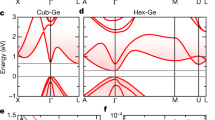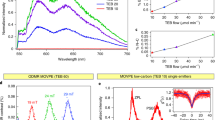Abstract
THE development of new electroluminescent materials is of current technological interest for use in flat-screen full-colour displays1. For such applications, amorphous inorganic semiconductors appear particularly promising, in view of the ease with which uniform films with good mechanical and electronic properties can be deposited over large areas2. Luminescence has been reported1 in the red-green part of the spectrum from amorphous silicon carbide prepared from gas-phase mixtures of silane and a carbon-containing species (usually methane or ethylene). But it is not possible to achieve blue luminescence by this approach. Here we show that the use of an aromatic species—xylene—as the source of carbon during deposition results in a form of amorphous silicon carbide that exhibits strong blue luminescence. The underlying structure of this material seems to be an unusual combination of an inorganic silicon carbide lattice with a substantial 'organic' π-conjugated carbon system, the latter dominating the emission properties. Moreover, the material can be readily doped with an electron acceptor in a manner similar to organic semiconductors3, and might therefore find applications as a conductivity- or colour-based chemical sensor.
This is a preview of subscription content, access via your institution
Access options
Subscribe to this journal
Receive 51 print issues and online access
$199.00 per year
only $3.90 per issue
Buy this article
- Purchase on Springer Link
- Instant access to full article PDF
Prices may be subject to local taxes which are calculated during checkout
Similar content being viewed by others
References
Hamakawa, Y. et al. Optoelectron. Dev. Technol. 4, 281–294 (1989).
Madan, A. & Shaw, M. P. The Physics and Applications of Amorphous Semiconductors (Academic, London, 1988).
Meier, H. Organic Semiconductors (Verlag Chemie, Weinheim, 1974).
Tawada, Y., Tsuge, K., Kondo, M., Okamoto, H. & Hamakawa, Y. J. appl. Phys. 53, 5273–5281 (1982).
Robertson, J. Phil. Mag. B66, 615–638 (1992).
Dischler, B. in Proc. Eur. Mater. Res. Soc. Symp. Vol. 17 (eds Koidl, P. & Oelhafen, P.) 189–201 (Editions de Physique, Les Ulis, Paris, 1987).
Robertson, J. Phil. Mag. B66, 199–209 (1992).
Birks, J. B. Photophysics of Aromatic Molecules (Wiley, New York, 1970).
Simon, J. & André, J.-J. Molecular Semiconductors (Springer, Berlin, 1985).
Munekata, H., Shiozaki, A. & Kukimoto, H. J. Lumin. 24/25, 43–46 (1981).
Munekata, H., Murasato, S. & Kukimoto, H. Appl. Phys. Lett. 37, 536–537 (1980).
Munekata, H. & Kukimoto, H. Appl. Phys. Lett. 42, 432–434 (1983).
Viehland, J., Lin, S., Feldman, B. J., Kilgore, K. & Jones, M. T. Solid St. Commun. 82, 79–81 (1992).
Snow, A. W. & Barger, W. R. in Phthalocyanines: Properties and Applications Vol. 1 (eds Leznoff, C. C. & Lever, A. B. P.) Ch. 5 (VCH, New York, 1989).
Nevin, W. A., Yamagishi, H. & Tawada, Y. J. appl. Phys. 72, 4989–4991 (1992).
Author information
Authors and Affiliations
Rights and permissions
About this article
Cite this article
Nevin, W., Yamagishi, H., Yamaguchi, M. et al. Emission of blue light from hydrogenated amorphous silicon carbide. Nature 368, 529–531 (1994). https://doi.org/10.1038/368529a0
Received:
Accepted:
Issue Date:
DOI: https://doi.org/10.1038/368529a0
This article is cited by
-
In situ-grown hexagonal silicon nanocrystals in silicon carbide-based films
Nanoscale Research Letters (2012)
-
Surface chemistry of porous silicon carbide
Journal of Electronic Materials (1998)
Comments
By submitting a comment you agree to abide by our Terms and Community Guidelines. If you find something abusive or that does not comply with our terms or guidelines please flag it as inappropriate.



